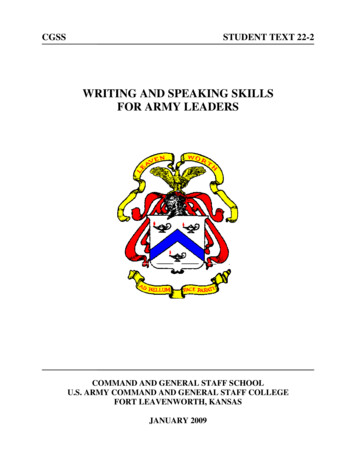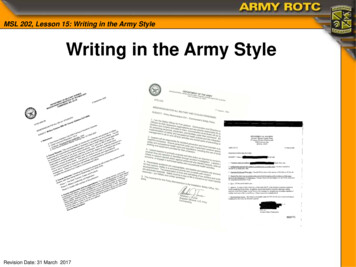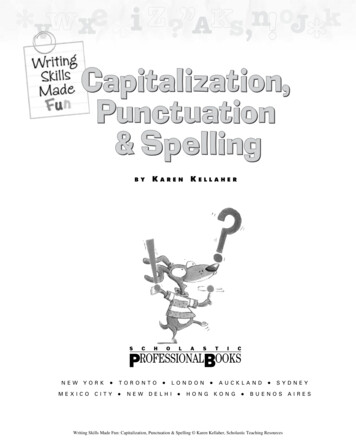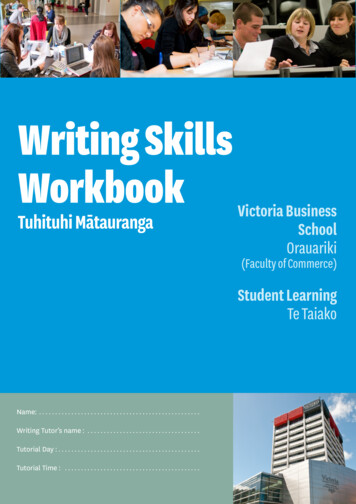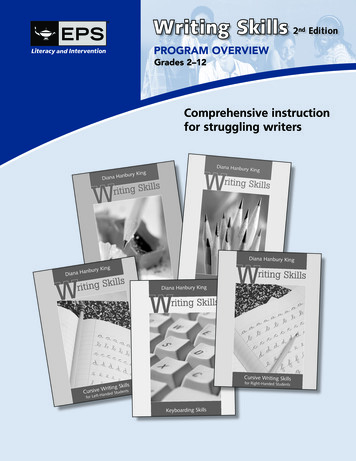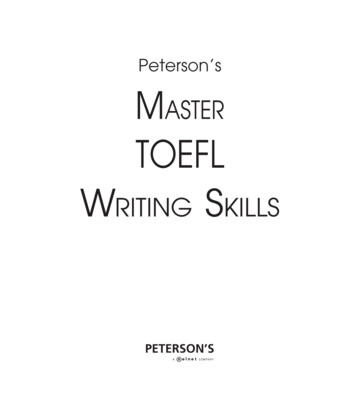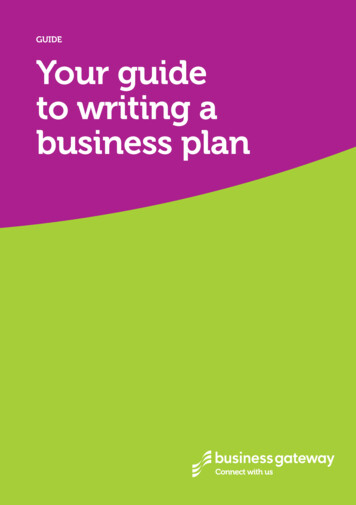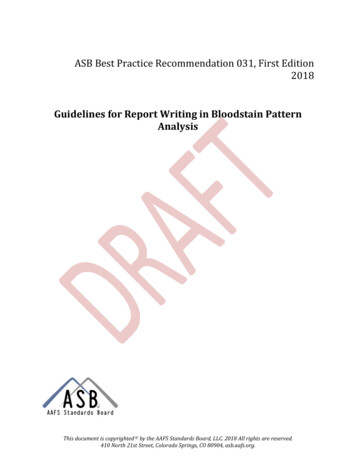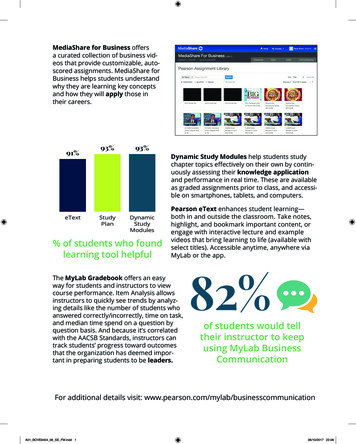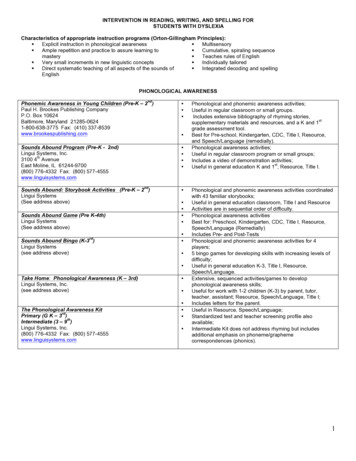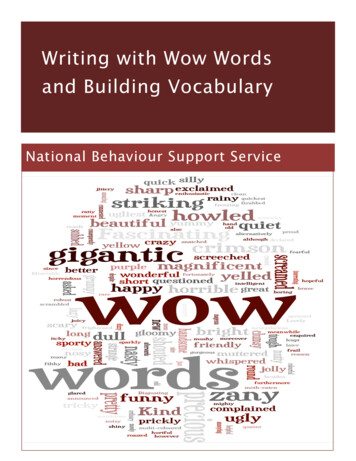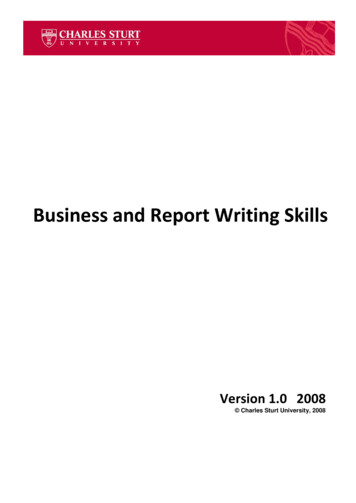
Transcription
Business and Report Writing SkillsVersion 1.0 2008 Charles Sturt University, 2008
Acknowledgement:Workplace Productivity Program (WPP) grant from DEEWR.Organisational Development Resources from Hedy Bryant, Narelle Marr and Judy Doulman.Business and Report Writing programs developed by Stacey Flanagan for CSU in 2007.Special thanks to Royal Melbourne Institute of Technology (RMIT) for permitting use of andreference to online resources.This module will also be available as an online resource on CSU Interact in the later half of2008. Charles Sturt University, 2008Learning resourceBusiness and ReportWriting SkillsOwnerCarissa MichelVersion:1.0September2008Summary/Overview of changesBusiness and Report Writing Skills at CSUVersion 1.0 2008
LEARNING IN THE WORKPLACETo continue to reinforce your learning from this workshop, when you return to your team use the tablebelow to assist you to reflect on the concepts introduced. Your reflection may also incorporate otherbehaviours that you have observed from other leaders within your workplace as well. You should aimto identify at least 10 different situations.Effective business andreport writing conceptsHow have you applied this? Tryto think of a specific worksituationWhat attributes of effectivebusiness and report writing didyou display?What was the outcome?Describe this in terms of thecharacteristics of effectivebusiness and report writing.As part of your reflection, identify some of your key strengths and opportunities for improvement in theway you apply business and report writing skills within the workplace. What steps might yoube able to take to improve your own practice?Business and Report Writing Skills at CSUVersion 1.0 2008
PROGRAM OVERVIEWThis program is designed to introduce some of the key concepts and skills supportingbusiness and report writing at Charles Sturt University (CSU).Although this program does highlight many important areas of business and report writing,further application of the concepts, principles and skills will help to refine and reinforce yourpractice. To this end, you are encouraged to expand your knowledge and skills by takingup work based or other, more formalised learning opportunities at the programs conclusion.Program Objectives:The key objectives of this program are to assist participants:1.)To develop or continue their understanding of Business Writing, Report Writing andBusiness Reporting Language (BRL) at CSU;2.) Familiarisation with CSU Business documents, templates and current workplacepractices at CSU;3.) Identify resources and strategies to help build greater business and report writingability.ICONSThe following icons appear within this learning resource. They highlight important informationas well as activities that can be completed:These are the outcomes that relate to a section of the resource.An Individual or group exercise.A key message or important pointSelf-reflectionThis is a workplace activityBusiness and Report Writing Skills at CSUVersion 1.0 2008
SESSION PLANTime 6-7 hours09.00 – 09.1009:10 – 9.3009.30 – 10.30ActivityIntroduction andObjectives, sessionoutlinePurpose of EffectiveWritingDifferent styles ofcorrespondence andCSU templatesCritical PointsTrainer and Training IntroEmergency Evacuation / housekeepingObjectives of session.Activity (10 min plus discussion) – What your messages reveal aboutyou and your company. Groups discuss, feedback and facilitatorwrites up on butchers paper.In this section we will discuss briefly the memo, email, business letters,business cases, minutes and agendas, as well as media releases.Examples of CSU templates are provided for all when available. LINKto CSU templates. Style ylemanual/appli/letterhead.htmlBusiness p.doc.10.30 – 10.4010.40 – 11.00MORNING TEABREAKWriting for apurpose, gettingstarted, planning.11.00 – 11.30Ensuringprofessionaldocuments.11.30 – 11.40Common BusinessLanguageEffective Emails11.40 – 11.5511.55 – 12.30Reviewing andproofreading CSUstyles and standardsHANDOUT – Key Points to writing a documentExercise – Using the 5W-H Plan for Writing template formulate a planfor a new idea or proposal you have been thinking about discussingwith your area and ask your group to review and give feedback. Keypoints whole group discussion by facilitator/participants.GRAMMAR: Quick grammar exercise (handout)HANDOUT – Some basic Grammatical Ideas (Appendix 4)Writing Powerful and Engaging Sentences. Creating Logic and Flow –Be clear, be concise, be complete, be correct, be concrete, beconvincing, be courteous.Define Common Business Language: Link to language documenton GOVT mework/common-businesslanguage.htmlHANDOUT: Appendix 1 Email Best Practice Guidelines, outlinepoints from presentationLink to Media website resources to help during the editing phaseincluding a glossary of terms and a Quick spelling ure/csuonly/media spelling.htmHANDOUT - Quick tipsLUNCH BREAK12.30 – 1.001.00– 1.30RMIT exercise,Learning skillswebsite.Preview Workplace Activity - RMIT Interactive web /4 WritingSkills/writing tuts/business %20english LL/tips/index.htmlPreview Workplace Learning activity: Student services learningskills website: 1.30 – 2.002.00 – 2.30Report Writing,purpose, planning,structureInitiativesManagementProcess at CSU.Representing DataVisually.Referencing Styles atCSU.Go over structure of reports as per notes and DLS guidelines.Link to Project Status Report Template, other templates on PSCwebsite.Link to Initiatives Management Process at CSU online s/form.htmGo over different examples of visual data, pros and cons . Goover CSU referencing doc Appendix /pdfs/apa2008.pdfBusiness and Report Writing Skills at CSUVersion 1.0 2008
Time 6-7 hours2.30pm – 2.402.40 – 3.00ActivityCommonabbreviations,quotations andadmitting biases,quick tipsAFTERNOON TEABREAKCritical PointsGo over as per manual, quick tips doc page 71Critique your reportGroup Exercise Critique your report:Draft a brief reportGROUP ACTIVITY – Draft a Brief Report Outline and if time thebeginnings of your report : Nominate a scribe to write on butcherspaper. Group discussion to follow.Conclusion, key points from the dayGroup Exercise: What have you learned today that you can takeback to your team and put into practice in your workplace?Further reading and resources. ANY Questions?Complete evaluation forms3.00pm – 3.153.15pm – 3.453.45 – 3.55Summary(Conclusion) andApplication, furtherlearningEvaluation3.55 – 4.00Business and Report Writing Skills at CSUVersion 1.0 2008
INTRODUCTIONPage 7TABLE OF CONTENTSLEARNING IN THE WORKPLACEPROGRAM OVERVIEWICONSSESSION PLAN3445PURPOSE OF EFFECTIVE WRITINGActivity – What your messages reveal about you and your company89DIFFERENT STYLES OF CORRESPONDENCE AND CSU TEMPLATESExercise – Critique and then create a CSU memoExercise – Critique then create a CSU letterWorkplace Learning Activity – Creating a business case made simple10121618WRITING FOR A PURPOSEExercise – How to start: Planning your writing2022ENSURING PROFESSIONAL DOCUMENTSExercise – Quick Grammar Exercise2525COMMON BUSINESS REPORTING LANGUAGE32EFFECTIVE EMAILSExercise – Email Best Practice Guidelines3434REVIEWING AND PROOFREADING: CSU STYLES AND STANDARDSQuick tips to help in editing your writingWorkplace Learning Activity – RMIT Writing tips interactive exercise373840REPORT WRITING: PURPOSE, PLANNING & STRUCTUREWorkplace Learning Activity – Student Services Learning GuidesReading – Division of Library Services Guidelines on Monthly Quarterly and Annual ReportsGroup Exercise – Critique a Report ExampleWorkplace Activity – Initiative Proposal Web Form4343456163REPRESENTING DATA VISUALLYGroup Exercise – Draft an Outline & Monthly Report6469REFERENCING STYLES AT CSU70COMMON ABBRIEVIATIONS71QUOTATIONS72ADMITTING BIASES AND WEAKNESSES OF YOUR REPORT73QUICK TIPS FOR REPORT WRITING74FURTHER TOOLS, TEMPLATES AND RESOURCES76LIST OF APPENDICIS76LIST OF REFERENCES AND FURTHER READING76Business and Report Writing Skills at CSUVersion 1.0 2008
PURPOSE OF EFFECTIVE WRITINGPage 8PART 1: BUSINESS WRITINGPURPOSE OF EFFECTIVE WRITINGWhy write?In business, in the workplace, and in our personal lives, we all stand to benefit from moreeffective communication skills. Writing is essential to communicate your message clearly andprofessionally and to incite action in those who you supervise, work with and require actionfrom.Many in the workforce today struggle with the basics of writing including grammar, spelling andpunctuation and this is what can hold them back and reduce their confidence when it comes tobusiness documents. The style and skills required for formal business writing are bestdeveloped by practice and experience, but with the right tools and know-how it is not hard toimprove.“The objective of communication is not the transmission but the reception.”Source: Dr Gerard M Blair (1991 – 1993)Adjusting writing style to suit topic and reader requirementsYou must adapt the content, tone and language of your documents to the situation (context)and intended audience of your communication.Some business documents and topics require more formal language than others. If unsureseek clarification before starting. For example, documents such as briefing notes, proposals,operational reports and scientific/research reports will require more formal language thanmemos to the social committee or emails to colleagues.Use “you” more than you use “I” or “we”.Use a writing style that is appropriate to the readerWrite from the reader‟s point of view, focus on their needs as well as benefits to them.Example:WRITER’S VIEWPOINTREADER’S VIEWPOINTOur copier makes the best Your copies will be the best you‟ve seen, when youcopies on the market today.use our copier.Consider these factors about your readers before composing your draft:Personality type:detail-orientedTechnical level:expertOperational role:ultimate itiatedgatekeeper.visionary.uninitiated.Based on: Flanagan, S. (2007), Business Writing Skills. For CSU Division of Human Resources Page 9.Business and Report Writing Skills at CSUVersion 1.0 2008
PURPOSE OF EFFECTIVE WRITINGPage 9Activity – What your messages reveal about you and your companyWith business writing, the pressure is on to communicate a clear and concise message withconsideration for the reader in mind.When you are writing a business letter, you want to enhance not only your image but yourcompany‟s image as well. Although it seems unfair, the truth is readers will equate weaknessesin your letters with weaknesses in you, or your company. What impressions do you get frombusiness writing with the following ical and spelling errorsStiff & formal writing styleLots of big, complex wordsVery short, concise sentencesSmudges on paper, tiny margins and weirdspacing between linesSource: Flanagan, S. (2007), Business Writing Skills. For CSU Division of Human Resources Page 7.Business and Report Writing Skills at CSUVersion 1.0 2008
DIFFERENT STYLE OF CORRESPONDENCE & CSUTEMPLATESP a g e 10DIFFERENT STYLES OF CORRESPONDENCE AND CSUTEMPLATESIn this section we will discuss briefly the memo, email (covered in more detail later in themodule), business letters, business cases, minutes and agendas, as well as media releases.Examples of CSU templates are provided for all when available.MEMORANDUM (MEMO)A memorandum (memo) is a piece of correspondence used within an organisation or amongvarious branches or divisions of the same organisation. A memo is usually sent through internalmail or via e-mail.Structure of the MemoOrganisation name, usually contained in the letterhead.Memo or Memorandum at or near the top of the page.Use the reader‟s full name with any professional title such as Dr but without thecomplimentary titles of Mr, Ms or Mrs.To:If you are sending the memo to several people, list them after “To”. If the list is longer than adozen names, place it at the end of the memo and reference it on the “To” line. For example:To: See distribution list on page 6.From:The writer‟s name and professional title go after this heading.Date:Dating a memo gives the organisation a record of its correspondence.Subject:State the topic in a few words but make sure it communicates the point of thememo. E.g. “Changes in Employee Medical Benefits” is more specific than“Employee Benefits Program”.NOTE: The order and placement of these headings may vary from organisation to organisation.The “To” line eliminates the need for a salutation (e.g. ”Dear Mrs. Bernstein”).MessageThe content of the memo should consist of a concise introduction, one or more middleparagraphs conveying the details, and perhaps a brief conclusion. Some memos are as shortas one paragraph, or even one sentence. Memo length is determined by the purpose andaudience.Memos longer than two pages generally have a more formal structure than shorter ones. A longmemo should have the following sections:A summary, placed at the beginning of the memo, should condense the subject to five orten lines. It should not contain jargon or highly technical language.Business and Report Writing Skills at CSUVersion 1.0 2008
DIFFERENT STYLE OF CORRESPONDENCE & CSUTEMPLATESP a g e 11The introduction states the memo‟s purpose and scope. You may add a paragraph or twoof background material if the reader needs more information. The introduction may also beused to ask or answer key questions, thank the reader, or give good news such as theapproval of a proposal. If you must refuse a
business and report writing at Charles Sturt University (CSU). Although this program does highlight many important areas of business and report writing, further application of the concepts, principles and skills will help to refine and reinforce your practice. To this end, you are encouraged to expand your knowledge and skills by takingFile Size: 1MBPage Count: 78Explore furtherThe Smart Guide to Business Writing - Origin Training Centrewww.otcbahrain.com(PDF) Report Writing: Process, principles and styleswww.researchgate.netSample Report - Wrightwww.wright.eduExecutive Secretariat - Guide to Document Preparationexecsec.od.nih.govRecommended to you based on what's popular Feedback
